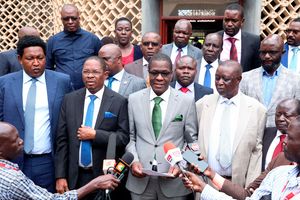Hungry Horn: Why region is facing more mouths in need of food

Bele Kalbi Nur walks with his goats in El Gel village, 8 kilometres from the town of K'elafo in Ethiopia on January 12, 2023. The last five rainy seasons since the end of 2020 have failed, triggering the worst drought in four decades in Ethiopia, Somalia and Kenya.
The Horn of Africa is extending a begging bowl, again, seeking food to feed more of its hungry mouths, and from the look of things, the situation may continue at least until next year.
Traditionally, it has been wars, banditry and general bad policy in investing in agriculture to blame for food shortage in the region. But experts now say external shocks have piled on the erratic weather to increase the blow.
Yet Agriculture is said to be the ‘backbone’ of the region. According to data from the Intergovernmental Authority on Development (IGAD), the Horn of Africa regional bloc, agriculture contributes to at least 15 percent of the national GDPs of the eight-member bloc. It employs two in every three people in the Horn which has an estimated population of 230 million.
The current food shortage was always coming. This year, a fifth consecutive rain season failed. And the shocks from the Russia-Ukraine war, the invasion of pests like locusts and Covid-19 piled the misery that has seen more than 23 countries across Sub-Saharan Africa face food shortage.
Across Africa, some 146 million people now need relief, according to data from the International Federation of the Red Cross and Red Crescent (IFRC). That will need at least $220 million to feed, this year alone.
In the Horn, wars and violence as in Sudan, South Sudan, Ethiopia and Somalia have added to the problem, according to an analysis by the UN Office for the Coordination of Humanitarian Agencies (UNOCHA), as the affected cannot be reached.
Mahboub Maalim, Special Adviser on Hunger Crisis at the International Federal of the Red Cross (IFRC) told Nation.Africa the problem for the region complex, with some causes being of their own making while the rest are beyond control.
“The danger is; this is very unprecedented. It has never been recorded that so many countries in Africa are experiencing hunger,” he told Nation.Africa.
“In this case it is more than 23, including those in the Horn. What this means is that the complexity of what has led to food insecurity is getting worse in the sense that there is a multiplicity or convergence of various issues,” he said in an interview, on the sidelines of a media café hosted by the IFRC on food security in Nairobi, last week on Wednesday.
Sudan, currently at war, had been receiving food aid long before the violence. By December 2022, UN agencies said 15 million Sudanese people nneeded assistance due to drought, floods, and disease outbreaks.

The Horn of Africa has long been prone to instability and conflict.
Now some 4 million people are displaced, 3 million Internally. Charity group CARE said this week thousands of these are also nursing wounds from the war which it said “has had an extreme impact on all including humanitarian workers.” Sudan’s situation is expected to feature prominently on Saturday when the world marks the World Humanitarian Day.
“This is well above the drought that we normally blame in these circumstances. It is floods, disease, Covid-19, yellow fever in some countries, pests, and chronic conflicts that have displaced people,” said Mr Maalim.
The experts had gathered to discuss the impact of all those forces to the food situation in the wider east Africa. But the problem is not unique here. Across the continent, one in ten people is hungry and even those with money may not be guaranteed of food due to political decisions around exports.
The worst of them is climate change.
“In Africa, everything for us is bad. When we have rain, we have floods. When we don’t have it, we have drought,” explained Mr Laurean Bwanakunu, the Head of Humanitarian Diplomacy and Regional Liaison for Eastern Africa at IFRC. In Kenya, at least 33 counties are food insecure, according to data by the Kenyan government after it recorded the worst rainfall in 40 years last year.
Mr Maalim, a former Executive Secretary of regional bloc, IGAD, knows climate change from the time he was young.
“When I experienced drought myself for the first time, it was in early 1970s. It used to be a ten-year span, then I witnessed a five-year span, two year-span…now it is perennial. The question now is not if, but when drought will happen,” he said.
“In the last drought in Kenya, a 90-kilo bag of maize would cost about Sh4,000 ($27.86) while a goat would cost about Sh200 ($1.39). If you are a livestock farmer, how many goats would you have to sell to get a bag of maize? It means the rural economies also collapse.
“The whole issue is multisectoral. The message we are passing is we need to work together. Coordination is easier said than done but we need to work together. And we need to leverage relief and longterm development.”
The pain of climate change may just eat into regional food plan. Recently, for instance, President William Ruto announced that Kenya is on course to meet national demand for maize, and could even have a surplus, a section of farmers were cautious over food insecurity.
President Ruto said from the long rains alone, the country is expected to harvest 44 million bags, compared to last year’s 32 million bags.
“The subsidised inputs have had a huge impact on our agriculture. We will have a bumper harvest this year,” Ruto said.
In 2017, Kenya produced 39.6 million bags of maize. In 2018, production rose to 44.6 million bags but later slumped to 39.7 million bags in 2019. In 2021, 40.2 million bags were produced and 43 million bags last year.
Kipkorir Arap Menjo, a director at the Kenya Farmers Association, warned that the country remains food insecure because the government failed to set aside funds in this year’s budget to cater for storage of the grain reserves.
“I agree with the President that we are likely to have a bumper harvest because fertilizer came in good time. The weather was also favourable.
“But now the trouble is that after the harvest we have post-harvest and market challenges,” said Menjo, who is based in the North Rift region, arguably referred to as Kenya’s food basket.
Menjo said the country has no strategic grain reserves despite the availability of stores.
In addition, the Russia-Ukraine conflict derailed access to cheap overseas imports by raising global grain prices and increasing shipping costs.
In 2023, the currency depreciation related to higher interests on US bonds increased inflation, sustaining higher maize prices.
“These frequent sequential or concurrent macro shocks have diminished seasonal fluctuations in most countries in East Africa, in which intra-annual price variations are slight and short-lived, except for transitions to a new year,” a report by the Food Security and Nutrition Working Group (FSNWG) says.
The report, East African Cross-border trade bulletin July 2023, East African Cross-border trade bulletin July 2023 was prepared by The Market Analysis Sub-group of the Food Security and Nutrition Working Group (FSNWG). It says that the 2022 drought heightened the prices of grains further as demand faced reduced supplies. FSNWG monitors informal cross-border trade of 88 food commodities and livestock in eastern Africa in order to quantify the impact on regional food security.
The report reveals that the volume of maize traded was 37 percent lower than in the previous quarter because of tight supplies from Uganda and Ethiopia during production.
Despite President Ruto’s hopes for a surplus harvest, the report warns that Kenya remains a maize deficit country.
Experts say the region should not overlook conflicts in the region as it could raise the number of mouths to be fed from smaller yields. Alyona Synenko, Spokesperson for the International Committee of the Red Cross in the region said relief workers are finding it harder to access Sudan and Somalia due to violence.
“We try to work with our movement partners in those areas but unfortunately it is it is very difficult because of the extremely volatile security situation,” she explained, referring to Darfur in Sudan, where war has hit recently, and central and southern Somalia, where extremist groups control.
“We are facing more than one conflict situation, including protracted conflict situations such as in Somalia…and that has had tremendous impact on the capacity of local farmers to produce food because people have been displaced, and also the climate shocks they are facing are making their situation very difficult.
In Africa, conflict is still a key driver of food shortage. But beyond the politics of war, however, the ICRC is pushing policymakers to discuss microeconomic issues around food, such as global financial, and geopolitical shocks and how it affects availability of grain and how it affects pricing.






